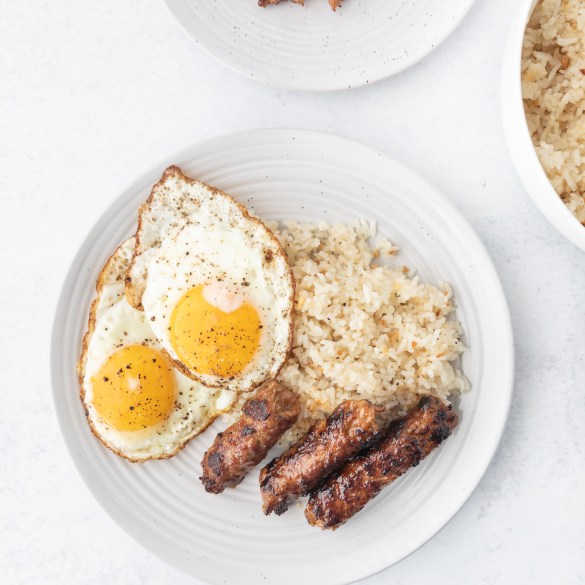If you’d like to try an alternative breakfast sausage, try making these skinless longganisa! Longganisa is a sweet, garlicky FIlipino breakfast sausage that is amazing to pair with crispy fried eggs and garlic fried rice.

Filipinos typically make longganisa with hog casings, but I made this recipe for a skinless version that is easier to make but just as delicious. This dish is a breakfast staple in many Filipino households, with its history dating back to the Spanish colonization of the Philippines.
There are various regional variations of longganisa, each with its own unique flavor profile. Some popular variations include an extra garlicky version, and a spicy version. While the traditional recipe calls for ground pork, you can also use alternative ground meat such as chicken or beef.
What’s in the longganisa?
Longganisa is made from ground pork mixed with soy sauce, vinegar, garlic and brown sugar to give it its signature flavor. The flavor is mostly reliant on the garlic and brown sugar components. Filipinos love their sweets and love their garlic. I don’t typically like things too garlicky, so I usually put slightly less than what’s traditional. Also, I don’t like to have the little minced chunks of garlic when I bite into longganisa, so I actually grate mine instead. Grating the garlic makes the garlic flavor a little more incorporated rather than too in-your-face.
Traditionally, Filipinos would add annatto or achuete powder to add a reddish color to the longganisa. This powder doesn’t really add any distinct taste — it’s just to add color. But for this recipe, I opted to add smoked paprika instead. I love the depth of flavor it adds to these sausages. If you only have regular paprika, that’s fine too. If you don’t have any paprika at all, you can omit it altogether.
Additionally, some recipes don’t use binders to help hold the longganisa mixture together, but I prefer to add it. Those who add binders to the sausages would typically use flour. For this recipe, I opted for cornstarch. The cornstarch absorbs moisture from the meat and other ingredients. It also forms a gel-like substance that makes it easier to form the longganisa into sausage shapes. This helps to ensure that the sausages hold their shape during cooking.
And lastly, you might have noticed an unorthodox ingredient in this recipe: Sprite. Filipinos tend to use Sprite, or other similar carbonated soft drinks, as a meat tenderizer and flavor enhancer. We add this sometimes to meat marinades and sauces. The carbonation in the soda helps to break down the proteins in the meat, making it more tender. Additionally, the sugar and acid in the soda can help to enhance the flavor of the meat.
What is a traditional Filipino breakfast?
If you’ve never had a traditional Filipino breakfast before, you are missing out! We typically eat longganisa with garlic rice, called sinangag, and fried eggs. This combination is called “silog.” Silog is a traditional Filipino breakfast that consists of a combination of a flavorful protein, garlic rice, and eggs. The “si” in “silog” comes from the “si” in “sinangag” or garlic fried rice. The “log” comes from “itlog,” which means egg in Tagalog. Since we’re making longganisa, we would call the whole breakfast dish as longsilog. Depending on which protein you use, then the first syllable prefixing silog would change. For example, if we pair spam or hot dog with garlic rice and eggs, then we would call it spamsilog and hotsilog, respectively. Other meats that are often used in silog include tapa (thin marinated beef), tocino (sweet FIlipino bacon), and daing (sun-dried fish).
What sets the Filipino breakfast apart from a typical American breakfast is the strong emphasis on savory dishes. In the Philippines, breakfast is a hearty meal that is meant to fuel the body for the day ahead. Of course, we have our more sweet breakfast options that can be considered more like “treats.” But in general, Filipino breakfast is meant to sustain us a little longer throughout the day.

What is the best way to form the longganisa into shape?
There are several ways you can form your longganisa into a typical sausage shape. My preferred way is to use a piping bag with a round piping tip. By using a piping bag, you can easily control the flow of the mixture and produce uniform longganisas that are the same size and shape. Simply fill the piping bag with the raw longganisa mixture, attach the round piping tip, and squeeze the mixture out onto a sheet of plastic wrap, wax paper, or parchment paper to form the sausage shapes.
Another option is to form the raw longganisa mixture into sausages by hand. To do this, you will need to wet your hands with cold water to prevent sticking. Then, take small portions of the mixture and shape into sausages of the desired length and thickness. This method can be messy, but you can also use plastic cling wrap, wax paper, or parchment paper to help you form the shapes.
If you prefer to not make the longganisa skinless and want to use casings, you can do that too. If you have a sausage stuffer, you can use this tool to fill hog casings with the raw longganisa mixture. In the Philippines, most people don’t have sausage stuffers, so they have a clever workaround to stuff longganisas into casings. They take a large plastic soda bottle and cut the bottom half off. With only top half, they turn it upside down. Then, they take the hog casing opening over the mouth of the bottle. And just like that, they have a makeshift sausage stuffer! Using a dowel or the handle of a wooden spoon, they push the raw longganisa mixture from the bottle into the casing.
Can I freeze some for later?
You can freeze raw longganisa for up to 3 months if stored in a freezer-safe bag or container. I would recommend shaping the logganisa into sausage shapes first prior to freezing though. When you are ready to cook the longganisa, simply remove it from the freezer and thaw in the refrigerator overnight. It’s important to note that freezing and thawing can affect the texture of the sausage, so it may not be as juicy or tender as freshly-made longganisa. However, the flavor should still be intact.

Ingredients
- 2 lbs ground pork (20% fat)
- 1/3 cup dark brown sugar*
- 2 tbsp soy sauce
- 1 tbsp vinegar
- 1 whole head of garlic (10-15 cloves), grated (or minced, if you prefer). If you have pre-minced garlic, you can measure about 1/3 cup of it
- 2 tsp salt
- 2 tsp pepper
- 1.5 tsp smoked paprika
- 2 tbsp cornstarch
- 3 tbsp Sprite
Instructions
- Put all the ingredients in a large mixing bowl and mix with your hands until everything is fully incorporated.
- Form into sausage shapes using your preferred method. I like to use a piping bag with a round piping tip. Simply fill the piping bag with the raw longganisa mixture, attach the round piping tip (about 3/4-inch in diameter), and squeeze the mixture out onto a sheet of plastic wrap, wax paper, or parchment paper to form the sausage shapes. Try to form them to about 3-4 inches long because they will shrink slightly when you cook them. At this point, you can cook them already. But if you have time to spare, it's best to at least chill them for an hour to let all the flavors sink into the meat. I usually make these at night and chill them overnight so they're ready for breakfast or brunch the next day.
- Once you're ready to cook, heat up a bit of olive oil in pan on the stove on medium-low heat. Once the oil is hot, add your longganisa in without crowding the pan. Cook each side of the longganisa for about 2 minutes each, or until the cooked side has formed a nice crust. Don't worry, it's not burnt -- it's just the brown sugar and Sprite that caramelized. We cook these in medium-low because you want the crust to develop while making sure the inside gets cooked thoroughly. If your heat is too hot, the outside will caramelize too quickly, and the inside might not be cooked enough. If that happens though, don't worry -- you can add a bit of water to the pan and close it with a lid to steam the longganisa to cook through.
- Serve with eggs and garlic rice!
Notes
- Dark brown sugar is preferable, but if you only have light brown sugar, that's fine too.
How should I cook the eggs?
In my silogs, I prefer to make my eggs sunny-side up with crispy edges. I heard that in culinary school, if you make crispy fried eggs, they’ll fail you. I’m not sure if this is true, but crispy fried eggs are delicious especially in silogs! The runny yolks add a creamy rich sauce to the rice, while the crispy whites add a satisfying crunch.
To make crispy fried eggs, heat up a small pan on the stove on medium-high heat with at least a tablespoon of oil (I use olive oil). As soon as the oil is hot enough, lower the heat to medium low. Then, carefully drop the egg in and season with salt and pepper. Cook until the edges are golden brown and crispy and the whites on the egg are set. If the edges are golden brown already but the whites are not yet set, put a lid on the pan so steam can cook the whites through.
If you don’t like sunny-side up or yolky eggs, you can definitely cook the eggs however you want. Sometimes, I crave scrambled eggs so I’ll eat that instead with the longganisa and garlic rice. It’s up to you!
How should I cook the garlic rice?
To make garlic rice, heat up olive oil on a deep skillet on medium-low. We want this on low because garlic burns easily. Add the minced garlic in, season with a pinch of salt, and cook until light golden brown. You’d want to stir occasionally to prevent the garlic from burning. Once the garlic is light golden brown, add day-old rice to it and stir everything together. Season with salt and pepper to taste, and cook until the rice is warmed through.
I personally prefer a bit of chewy, crunchy bits of rice, so I cook it slightly longer to get that texture. To ensure enough garlic flavor to the rice, I’d say use fresh garlic as much as possible and roughly chop it yourself. I would also recommend that for every 1 cup of day-old rice, use about 1.5 tbsp of minced garlic, 1 tbsp of olive oil, and 1/4 tsp of salt.
If you’re in a pinch, and you don’t have the time to have day-old rice, you can quickly grab a Minute White Rice from a grocery store. I love keeping this instant rice option in my pantry! After microwaving it per the instructions, just fluff it up and wait about 2 minutes before cooking it with your light brown garlic. I have found that this instant rice doesn’t get mushy like regular freshly-cooked rice when making fried rice.

Looking for more Filipino recipes? Browse here!
// ON THE SCENE
- Bottom backdrop: Replica Surfaces — Cement
